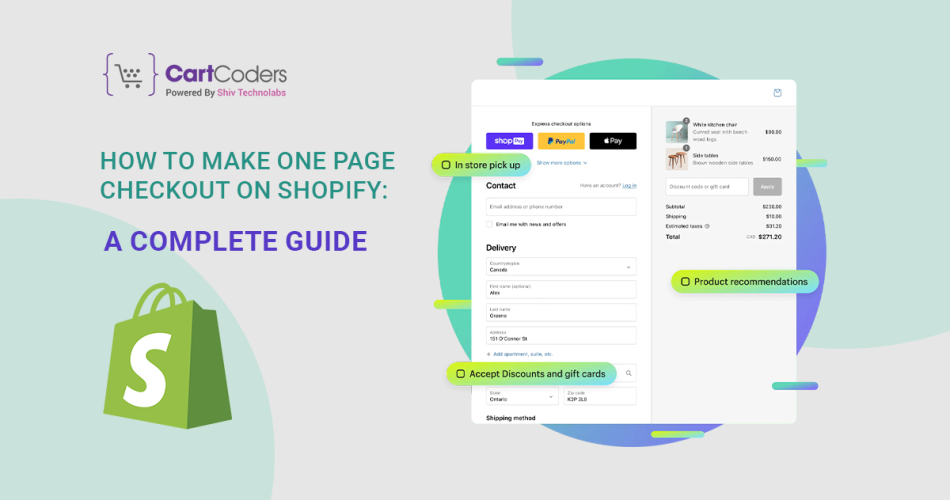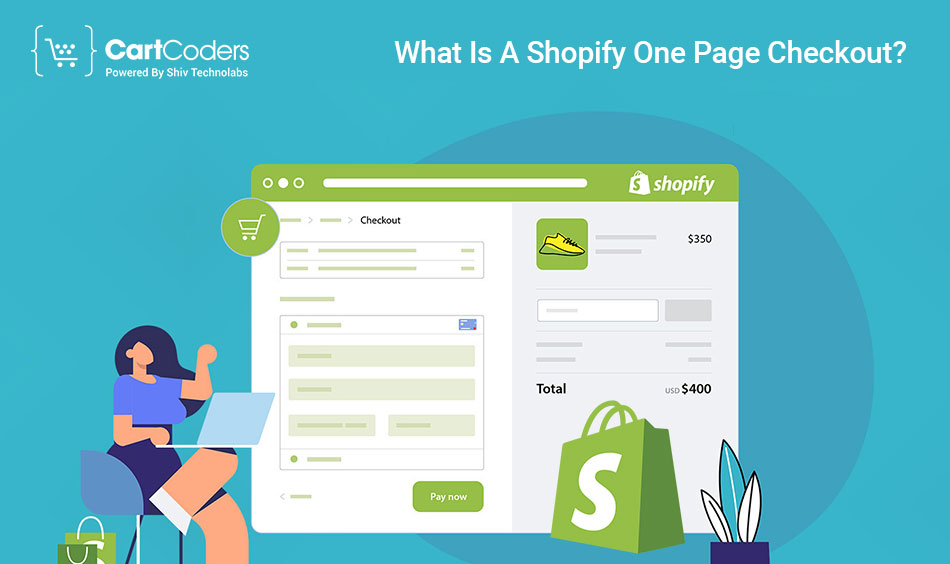Custom Engagement Solutions
Unlock tailored solutions with a free, no-obligation strategy session.
Expert Developers & Engineers on Demand
Scale Your Team with Skilled IT Professionals
Expert Guidance for Digital Transformation

Want to make it quicker and easier for customers to check out on your Shopify store? This might mean you are thinking about having a one page checkout. This post will examine a one page checkout and how you can create it for your Shopify store.
This blog provides enough information to determine whether a one-page checkout suits your firm’s operations. Let us begin!

The Shopify one-page checkout is designed to make online shopping as easy and quick as possible. This way, customers can quickly fill in all their order details on a single page and have it processed.
Rather than filling out multiple pages with billing, shipping, and payment information, shoppers only have to enter the necessary details once on a single page.
One page checkout is becoming popular because it makes the buying process shorter and faster. Instead of going through several steps, everything happens on a single page.
While this sounds simple, it has both advantages and drawbacks.
A single-page checkout helps reduce steps for buyers by putting all the required fields—shipping, billing, and payment—on one page.
Shopify introduced this option to give merchants more control over their checkout process.
Here’s how you can set it up properly:
This is the control panel where you can access all store settings, including checkout.
From the left-hand menu, click on Settings → Checkout.
Scroll down to the checkout customization section. Depending on your plan, Shopify gives you the option to switch between multi-step and one-page checkout.
Choose the one-page checkout option. This will combine customer information, shipping, and payment into a single page.
Click Save to apply the new checkout format.
Go to your store, add a product to the cart, and complete a test order to check how the one-page checkout looks and functions.
If you want extra customization like upsells, custom fields, or design tweaks, you can install Shopify apps such as:

The benefits of a one-page checkout are numerous:
Must Read: Ways To Optimize Your Shopify Plus Checkout For Conversion
Once you have the app of your choice or have access to the native option, your one-page checkout design should be aimed at achieving maximum efficiency as well as conversion. Here are a few tips:
Bonus Tip: Try different layouts, colors and features in your A/B testing to find what resonates most with your customers. To get the best performance for your one-page checkout, you need data-driven decisions.
Remember: But, a one-page checkout is not a panacea. Even if it can greatly increase your conversion rates, it is only a part of a bigger picture. Your product pages should be informative and attractive, shipping prices should be competitive while the customer service must always be on top form to provide for a seamless shopping experience that will make customers keep coming back.
By doing this, you may turn your Shopify checkout from being an obstacle into a path to increased sales and satisfied customers. Henceforth, forget the maze of multiple pages and embrace simplicity of one page checkouts. And that’s why you need to use single step checks outs in shopify.
Many business owners believe one-page checkout is the best way to increase sales. However, this may only be true for some firms. A simple Shopify One-page checkout works well for young or mobile audiences and lowers “average order value” products.
On the other hand, a multi-page checkout process might be more effective for businesses selling expensive products and looking for opportunities to cross-sell and upsell their customers.
For Shopify users, there is more to a one-page or multi-page checkout than the number of pages. For example, the header layout of your one-page checkout will differ, which may affect how your background image appears on a custom checkout. Also, with single page system, the words “checkout page” and “system” can be customized by editing some words in the theme content editor’s “checkout and system.”
Shopify store owners can include a one-page checkout feature in their stores as it makes customers go through the checkout process easier and boosts sales. However, there are some things to think about before going this route.
To find out how you can raise your AOV, it is better to try CartCoders, though we suggest whether to set up your own one-page Shopify checkout. You may install it from the Shopify App Store or book a demo from our website.
There is a possibility of enabling one page checkout on Shopify by using third-party apps like “CartHook” or “One Page Super Checkout.” Get the app you would like to use from the Shopify App Store, follow the setup steps and customize its settings in line with your store’s branding as well as preferential parameters. The moment it is set, your clients will undergo a simplified transaction process through a single page.
Indeed, many One-Page Checkouts within Shopify have customizable options. You possibly may select which particular fields to include, such as billing and shipping information, order summary, and payment details among others. Customize layout and design to match your store’s aesthetic for a seamless, branded checkout experience.
One-page Checkouts work with different themes in Shopify. For this feature to function, there is no particular theme that you should have. However, it is advisable to see how compatible the chosen one-page checkout app is with your preferred theme so that it can be smoothly integrated and visually appealing too.
Most One Page Checkout apps are designed with a mobile-first approach. Pick one that is compatible with mobile devices and has a user-friendly checkout page regardless of screen size. Many reliable One Page Checkout apps adjust the layouts for both desktops and smartphones, ensuring seamless transitions between both.
Definitely, tracking can be done on Shopify through their analytics dashboard or using features provided by your choice app. The success of streamlined checkout process can be measured by looking at such metrics as conversion rates, deserted carts etc. Using this data will help you make informed choices and more finely tune the One Page Checkout in order to deliver even better results.
Projects delivered in 15+ industries.
95% retention rate, building lasting partnerships.
Serving clients across 25+ countries.
60+ pros | 10+ years of experience.